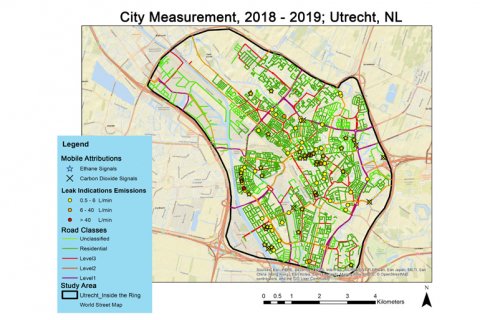Scientists discover more methane leakages in Utrecht’s gas distribution network
Publication in Atmospheric Chemistry and Physics
Methane is not only a greenhouse gas, but also an important source of energy. The Netherlands has a large network of natural gas pipelines, which gas companies keep a close eye on in order to repair leaks quickly. Previous research in the United States has shown that new, more sensitive equipment detects considerably more gas leaks than equipment currently used by gas companies. This also appears to be the case in Utrecht and Hamburg, researchers write today in the scientific journal Atmospheric Chemistry and Physics.

The researchers discovered a total of 81 methane sources in Utrecht. Around two thirds of these were of fossil fuel origin, indicating that they are caused by leaks in gas pipes. The researchers estimate that in Utrecht alone, a total of 120 tonnes of methane per year is lost via gas leaks. The study is especially timely as only a few weeks ago, the European Commission proposed a strategy to reduce methane emissions as part of the European Green Deal.
Gas network operators
The researchers shared their results with the gas network operators in both cities, Stedin Utrecht and GasNetz Hamburg. Both gas network operators prioritized repairs of the locations with the highest emissions. One third of total detected methane emissions in Utrecht originated from one single leak indication, which Stedin had already fixed by the time the results had been analysed, as part of a regular operation to replace gas pipelines.
Although Stedin located and repaired the largest leaks, these locations were only part of the list of fossil-attributed leak indication from this study. “This is similar to other cities in Germany and the US, where it turned out that gas network operators were able to find more leaks when they visited locations together with scientists with high sensitivity instruments,” says Hossein Maazallahi, who carried out the measurements as part of his PhD research in Utrecht and Hamburg.
3D visualisation of the detected methane leaks in Utrecht and Hamburg
Strong recommendation
Based on the results, the researchers strongly recommend gas operators to start using mobile measurements as a fast and accurate technique for observing and identifying even small methane leaks across cities. “Gas network operators are surprised at the far greater number of possible gas leaks we can detect with our measuring method,” says research leader Thomas Röckmann. “They often see small signals as false alarms, but we are convinced that these are actually small gas leaks.”
Adapted Volkswagen van
To detect the leaks, the researchers built advanced measuring equipment into a Volkswagen van and drove approximately 1300 km within the city of Utrecht. In addition to methane, they also measured the concentration of some other gases, enabling them to determine if the source of methane was fossil (indicating gas leaks), combustion (e.g. incomplete combustion of compressed natural gas cars) or microbial (indicating organic sources, such as waste water treatment plants).
Publication
Methane mapping, emission quantification and attribution in two European cities; Utrecht, NL and Hamburg, DE
Hossein Maazallahi*, Julianne M. Fernandez, Malika Menoud*, Daniel Zavala-Araiza*, Zachary D. Weller, Stefan Schwietzke, Joseph C. von Fischer, Hugo Denier van der Gon, and Thomas Röckmann*
Atmospheric Chemistry and Physics, 7 December 2020, DOI 10.5194/acp-2020-657
* researchers affiliated with Utrecht University

